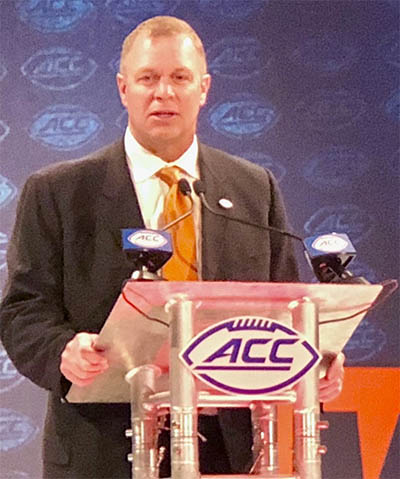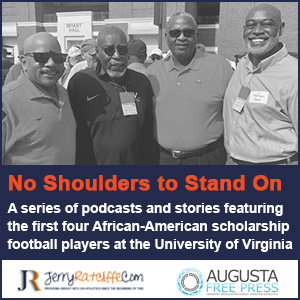Bronco Clarifies Earlier Comments About ACC-Caliber Players
It was inevitable that media attending this past week’s ACC Football Kickoff event in Charlotte would bring up Virginia coach Bronco Mendenhall’s comments to the school’s Board of Visitors in June, particularly the remark about having but 27 ACC caliber players on the roster.
The original report from a different publication didn’t clarify at the time Mendenhall had referred to his roster at that exact time. His number didn’t include players that had just graduated, the likes of Quin Blanding, Micah Kiser, Andrew Brown, Kurt Benkert, and several other departed players.

That number also did not include players that would transfer into the program or incoming true freshmen that would report in July, and that the number 27 was subjective.
To further clarify Mendenhall’s comments, there is something else fans should know. While he and his staff are pursuing high-caliber recruits, he is also gambling on taking some prospects that are not ACC-caliber players with the full intentions of developing them to the level where they can compete and perhaps even excel in the ACC.
“Recruiting is one way to build your roster,” Mendenhall said. “Development, which is something I’m most passionate about, is the primary way to develop your roster. And that number (27) better be changing even as we are talking.”
Anyone who has been around Mendenhall very long realizes that he’s all about transparency, even if it means being blunt to his own players. He’s not going to blow sunshine their way if it’s not deserved.
“My message is very simple,” the coach said. “I’m not going to pretend a player is currently an ACC player if his numbers say he’s not. But what is clear is, ‘Get to work.’ This is what you have to do and by this time we need you to be [here].”
Because Virginia’s program measures football players in every conceivable measurement, all the players know where they rank.
“The way our whole program is designed, there’s different levels of advancement,” Mendenhall explained. “They know really clearly where they stand and what they have to do to become, because they’re not going to play unless they become that [level].
“What better way to develop people than give them an exact idea of where they stand and what they have to do to advance,” Mendenhall said. “I love the approach. Some might not. Bottom line is, ‘You can always become.’”
The Cavaliers coach detailed how he takes developmental players every year with the full intention of coaching them up to reach their potential and contribute to UVa’s program. His only question is how long will it take them?
While Mendenhall doesn’t prefer the traditional “star ratings,” such as a 3-star, 4-star, etc., he used it as an example to explain his point.
“Let’s say a 3-star player, which is usually a developmental player where you’re not expecting them to start Year One, may not Year Two, but Year Three they might,” Mendenhall said. “I will take players that will become ACC players. It’s just how long will they take?
“I hope we are picking gritty, determined, and hardworking ones that will accelerate that time frame,” he said.
Mendenhall used present senior outside linebacker Chris Peace, who led all linebackers in the ACC in quarterback sacks last season, as a prime example of his philosophy.
“Chris Peace wasn’t one of the most highly recruited,” the coach said. “His work ethic is uncommon. Olamide Zaccheaus (whose 85 receptions last season was a UVa single season record), is another (3-star example). He became [ACC caliber].”
Further explaining his philosophy, Mendenhall noted that say his staff is recruiting prospects for the Wahoos secondary. Say his secondary two-deep is loaded, but recruiting calls for taking one prospect in the class to keep the numbers right.
“We could take one player that has to play his first year,” Mendenhall said. “But this [other prospect] could probably play in year two or year three. We actually recruit to slotted positions of development in relation to the entire need of the position.
“Some positions we’ll say we can’t take a player there unless he can play first year,” the coach continued to explain. “We don’t have time for that. We slot it just like that. We need a first year contributor, second year contributor, and a third year contributor.”
Because new UVa director of athletics Carla Williams has recognized the deficiencies in the football program, she has approved hiring of additional personnel in terms of strength/conditioning and recruiting. With additional eyes to find prospects, Virginia has its most commitments (17) at this time of the year than in Mendenhall’s previous two seasons in Charlottesville.
The coach likes those numbers, something that compared to his quotas when he led BYU to 11 straight bowl games before coming to UVa.
“I had about 85 percent [of a recruiting class] committed after June,” Mendenhall said. “That would be my ideal at Virginia as well, by the time June is over, going into the July dead period.
His theory is that the prospects who remain post summer are highly recruited players who don’t know what they want except signing day to them is all about attention in leveraging a lifetime experience with the hats at their press conference and all that jazz.
However, he believes his recruiting effort at Virginia is picking up steam.
The Wahoos picked up a pair of 4-star prospects recently (a defensive tackle and a linebacker). The remaining 15 commitments are 3-stars.
“I believe the reason players are choosing Virginia now is that they know our track record as a coaching staff, they believe we will win, they’ve seen tangible results in two years,” Mendenhall said. “But really, we’re winning on relationships, true and authentic, and sincere relationships which is the most lasting. The players that are coming, are coming because of that in my opinion.”








